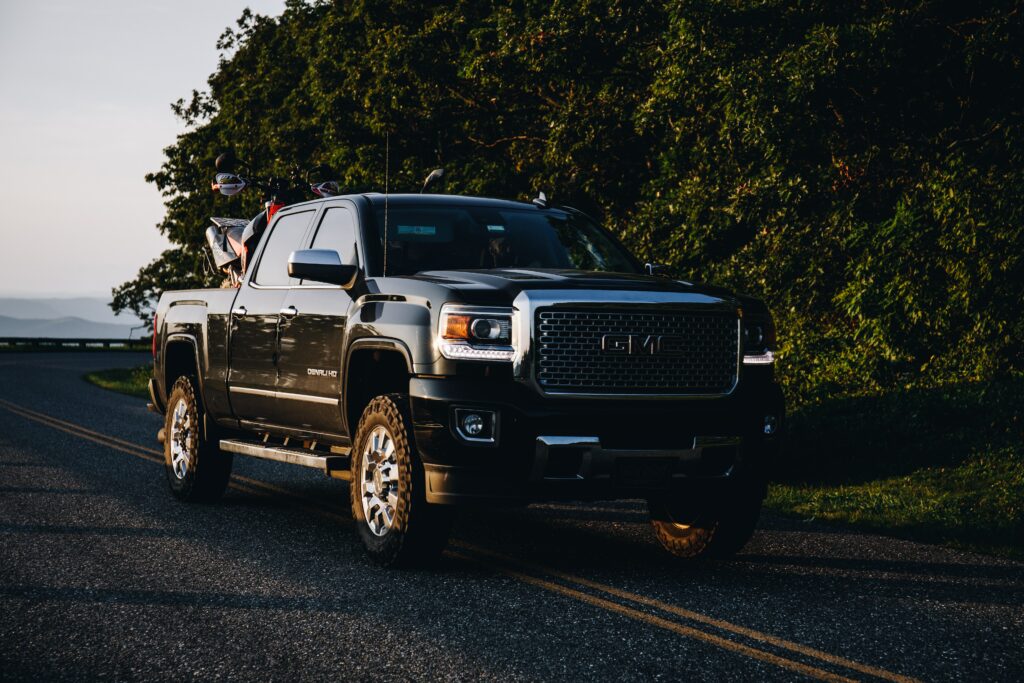Before you can confidently tow anything, from trailers, to passenger vehicles, motorcycles, or RVs, it’s important to understand how much your truck can handle. Towing more than your vehicle is rated for will put stress on your engine, transmission, tires, and brakes — and could put your safety at risk. On the other hand, you don’t want to spend a ton of money on a towing vehicle that’s way more than you need.
In this post, we’re going to get into towing capacity, what factors allow your vehicle to tow heavier loads, and some helpful terms to help you calculate the towing power you need.
4 Towing Capacity Terms to Know
Before you can calculate how much your truck can tow, these four terms are essential for understanding towing capacity.
- Curb Weight: your vehicle weight, not including passengers or cargo. Curb weight does include a full tank of gas and topped-off fluids and the average driver weight.
- Payload Capacity: the amount of additional weight you can safely add to your vehicle’s curb weight in the cab and cargo area.
- Gross Vehicle Weight Rating (GVWR): The total weight the vehicle can handle, which includes passengers, cargo, fuel and engine fluids. This value should be displayed on the sidewall plate or on the driver’s side door.
- Gross Combined Weight Rating (GCWR): The maximum allowed weight of the towing vehicle (GVWR) plus the allowed weight of towing equipment or trailer. Essentially, the weight of your loaded vehicle and equipment. The distributed weight on the equipment or trailer’s axles in addition to your vehicle’s allows you to tow above your payload capacity.
Factors Affecting Towing Capacity
While vehicle size can influence its towing capacity, it’s not the only factor. Towing capacity is determined by a combination of vehicle horsepower, weight, engine type and more. Let’s explore the factors that give vehicles their towing capacity:
- Horsepower: A high-horsepower engine will allow your towing vehicle to handle the additional weight of a towed vehicle, boat, motorcycle, RV, etc.
- Weight: Vehicles used for towing generally need to be heavy. Lifting and towing a vehicle puts stress on the rear of the vehicle. The rear axle then becomes the fulcrum, causing the front end of the wrecker to rise if it is not properly counter-balanced.
- Engine: Vehicles used to tow lighter items, like small vehicles or trailers, can have gasoline engines, but tow trucks with powerful diesel engines are able to provide more torque and thus capable of towing a larger load.
- Tires: Heavy duty tires become more important the heavier the vehicles you tow, as having a larger wheel base and better traction grant improved stability and performance.
- Equipment: As vehicles increase in towing capacity, so does the variety of equipment — pulleys, cranes, winches, wheel lifts, etc. Safety requirements for towing equipment are also determined by the category of towing capacity: light duty, medium duty, or heavy duty towing.
Light, Medium, and Heavy Duty Towing Capacity
There are three basic categories of towing capacity. Different types of tow trucks may be required for each type of towing.
Light Duty Towing
Light duty towing vehicles include large, sturdy pickup trucks with towing equipment installed on the back. These vehicles have a minimum gross vehicle weight rating of 5 tons, with a towing capacity of 7,000 to 11,000 lbs.
They are commonly used to tow most small vehicles and trucks for repossession, municipal towing or roadside assistance. Light duty equipment should include a powered winch and cable and a wheel lift.
Medium Duty Towing
Medium duty towing vehicles include flatbed tow trucks and hook and chain tow trucks. They have a gross vehicle weight rating of 11 tons at minimum, with a towing capacity up to 17,000 lbs.
Medium duty towing for towing heavier passenger vehicles, trucks, and off-road recoveries. Towing equipment, including a 12-ton capacity boom lift, 5-ton winches and wheel lifts, are used to hold the entire vehicle off the road, either in a bed or suspended.
Heavy Duty Towing
Heavy duty towing vehicles are the largest and heaviest in the towing fleet. With a gross weight vehicle rating of 23 tons, they can recover and carry vehicles from 17,000 lbs and up, including loaded tractor-trailers.
Heavy duty towing vehicles typically use a 25-ton single or double boom lift, one or more 25-ton winches, and a 6 ton wheel-lift.
How Much Towing Capacity Do I Need?
The ideal towing capacity for you depends on what you’ll be regularly towing. For example, if you intend on starting your own towing company and recovering large, heavy equipment, you’ll need to invest in a sizable wrecker with the right equipment permanently installed.
However, if you plan to do more light duty towing of small passenger vehicles, motorcycles, watercraft or lighter-weight items, then light duty towing equipment like a slide-in wheel lift will not only do the job, but save you a significant amount of money.
The Minute Man Wheel Lift Tow Truck provides sturdy and reliable light duty towing and can be installed easily onto your own vehicle. It’s ideal for applications in repossession, municipal towing, and roadside assistance.
If your pickup or cab-chassis meets the minimum GVWR of 10,000 lbs, the Minute Man XD Slide can offer a lift capacity of 3,500 lbs and a towing capacity of 7,500 lbs.
This labor and cost-saving tool conveniently attaches and stows for powerful towing capability wherever you are. If you’re ready to try an affordable, light-to-medium duty towing solution, contact us today.
Legal Disclaimer: The material and information contained on this website is for general information purposes only. You should not rely upon the material or information on the website as a basis for making business, legal or other decisions.

